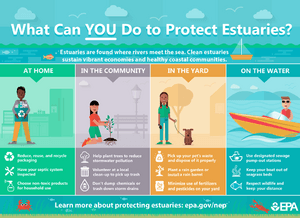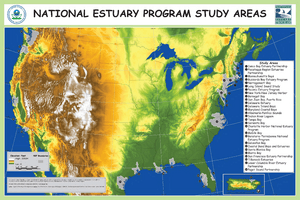National Estuary Program facts for kids
The National Estuary Program (NEP) is a special program in the United States. It gives money to states where leaders have found important estuaries that are in danger. These dangers can come from pollution, too much building on land, or too much use. There are 28 such estuaries that leaders have pointed out. The Environmental Protection Agency (EPA), a government group that protects our environment, gives money to these states. This money helps them create plans to bring these estuaries back to health and keep them safe. The U.S. government started the NEP in 1987 as part of the Clean Water Act, a law that helps keep our water clean.
How the Program Works
The National Estuary Program is made up of 28 smaller groups. Each of these groups focuses on a different estuary in its local area. Local people and staff run each estuary organization. Groups involved can be schools, local non-profit groups (who help without making money), and government offices.
The main job of the NEP is to help communities better protect, fix, and care for their estuaries. The NEP works differently from older ways of protecting nature. It looks at more types of problems and works closely with local communities.
Before this national program, some small local groups tried to help the environment. But their efforts weren't always enough. Now, the programs don't just focus on clean water. They also work to keep the whole estuary system healthy. If all parts of an estuary are not cared for, it might not be able to handle changes. This could cause the natural system to break down. This means looking at the chemicals, physical features, and living things in the estuary. It also means thinking about how people use the estuary for jobs, fun, and its natural beauty. This way, communities living near these water areas get both local and national protection. The EPA gives money and expert help to these local estuary programs every year.
Problems Estuaries Face
Each coastal area in the program has faced different levels of damage. This damage affects water quality and natural homes for animals and plants. Many local estuary programs have started projects to fix these common problems:
- Changes to how water flows, like from dams or canals
- Climate change, which affects weather and water levels
- Fewer fish and wildlife populations
- Loss of natural homes for animals and plants
- Invasive species, which are plants or animals that don't belong there and cause harm
- Pollutants:
Local Estuary Programs
- Albemarle - Pamlico National Estuary Program, Virginia/North Carolina
- Barataria-Terrebonne National Estuary Program, Louisiana
- Barnegat Bay Partnership, New Jersey
- Buzzards Bay National Estuary Program, Massachusetts
- Casco Bay Estuary Partnership, Maine
- Charlotte Harbor National Estuary Program, South Carolina
- Coastal Bend Bays and Estuaries Program, Texas
- Delaware Center for the Inland Bays, Delaware
- Galveston Bay Estuary Program, Texas
- Indian River Lagoon National Estuary Program, Florida
- Long Island Sound Study, New York
- Lower Columbia Estuary Partnership, Oregon/Washington
- Maryland Coastal Bays Program, Maryland
- Massachusetts Bays National Estuary Program, Massachusetts
- Mobile Bay National Estuary Program, Alabama
- Morro Bay National Estuary Program, California
- Narragansett Bay Estuary Program, Rhode Island
- New York-New Jersey Harbor Estuary Program, New York
- Partnership for the Delaware Estuary, Delaware
- Peconic Estuary Program, New York
- Piscataqua Region Estuaries Partnership, Maine/New Hampshire
- Puget Sound Partnership, Washington
- San Francisco Estuary Partnership, California
- San Juan Bay Estuary Partnership, Puerto Rico
- Santa Monica Bay Restoration Foundation (now Bay Foundation), California
- Sarasota Bay Estuary Program, Florida
- Tampa Bay Estuary Program, Florida
- Tillamook Estuaries Partnership, Oregon
Sharing Information
There have been some questions about how open one local National Estuary Program was with its information. A judge found that the Santa Monica Bay Restoration Commission, which is connected to the Bay Foundation and gets money from the EPA, did not follow a law about sharing public records. This means they didn't share information as openly as they should have.



